
A more recent article on long-term opioid therapy for nonterminal pain is available.
Am Fam Physician. 2016;93(12):982-990
Related Practice Guideline: CDC Develops Guideline for Opioid Prescribing
Patient information: See related handout on avoiding problems from opioid pain medicine, written by the authors of this article.
Author disclosure: No relevant financial affiliations.
Evidence supports the use of opioids for treating acute pain. However, the evidence is limited for the use of chronic opioid therapy for chronic pain. Furthermore, the risks of chronic therapy are significant and may outweigh any potential benefits. When considering chronic opioid therapy, physicians should weigh the risks against any possible benefits throughout the therapy, including assessing for the risks of opioid misuse, opioid use disorder, and overdose. When initiating opioid therapy, physicians should consider buprenorphine for patients at risk of opioid misuse, opioid use disorder, and overdose. If and when opioid misuse is detected, opioids do not necessarily need to be discontinued, but misuse should be noted on the problem list and interventions should be performed to change the patient's behavior. If aberrant behavior continues, opioid use disorder should be diagnosed and treated accordingly. When patients are discontinuing opioid therapy, the dosage should be decreased slowly, especially in those who have intolerable withdrawal. It is not unreasonable for discontinuation of chronic opioid therapy to take many months. Benzodiazepines should not be coprescribed during chronic opioid therapy or when tapering, because some patients may develop cross-dependence. For patients at risk of overdose, naloxone should be offered to the patient and to others who may be in a position to witness and reverse opioid overdose.
Opioid analgesics have historically been prescribed for acute trauma, perioperative care, cancer pain, and pain associated with life-limiting illness. Over the past several decades, opioids have been increasingly dispensed chronically for many nonacute conditions. More than one-half of patients who receive continuous opioid therapy for 90 days are still receiving opioids more than four years later.1 By sheer volume, family physicians prescribe more opioid analgesics than any other subspecialists.2
WHAT IS NEW ON THIS TOPIC: CHRONIC OPIOID THERAPY
The Centers for Disease Control and Prevention recently published new guidelines on prescribing opioids for chronic pain ( http://www.cdc.gov/mmwr/volumes/65/rr/rr6501e1.htm).
Clinicians should perform ongoing risk-benefit assessments throughout the course of chronic opioid therapy because problems can arise at any time. Patients receiving chronic opioid therapy should be reevaluated at least every three months—even when stable and doing well—and more frequently if problems arise.
| Clinical recommendation | Evidence rating | References |
|---|---|---|
| Consider buprenorphine formulations as an alternative to other opioids to treat chronic pain in patients at increased risk of opioid misuse, opioid use disorder, or overdose. | C | 16 |
| Pain that progresses despite chronic opioid therapy may represent opioid-induced hyperalgesia. Taper the opioid and wait until acute withdrawal resolves before reassessing pain. Inform the patient that opioid withdrawal is associated with physical pain, and does not necessarily represent progression of the underlying disease. | C | 24–28 |
| When opioid misuse is detected, do not terminate the patient from your practice or refuse to prescribe further opioid therapy. Instead, add opioid misuse to your problem list and intervene to change the patient's behavior. If aberrant behavior resolves, reward course correction. If aberrant behavior continues, consider the diagnosis of opioid use disorder and treat (or refer) accordingly. | C | 29–34 |
| Offer naloxone to patients at risk of opioid overdose. | C | 35–37 |
| To mitigate the risk of overdose, do not prescribe benzodiazepines concurrently with chronic opioid therapy. Also, avoid benzodiazepine coprescribing as treatment for opioid withdrawal, especially in patients with opioid misuse or opioid use disorder. | C | 10, 15, 35, 36, 38–41 |
| When discontinuing opioids, decrease the dosage slowly, especially in patients who experience intolerable withdrawal. Standard recommendations to decrease the dosage by 5% to 10% of the starting dosage every one to four weeks may still be too fast for some patients, especially those on long-term high dosages. Some patients may need to decrease by as little as 5% or less every two to three months, with even smaller decrements toward the end of the taper. It is not unreasonable to take many months to wean some patients off chronic opioid therapy. | C | 60 |
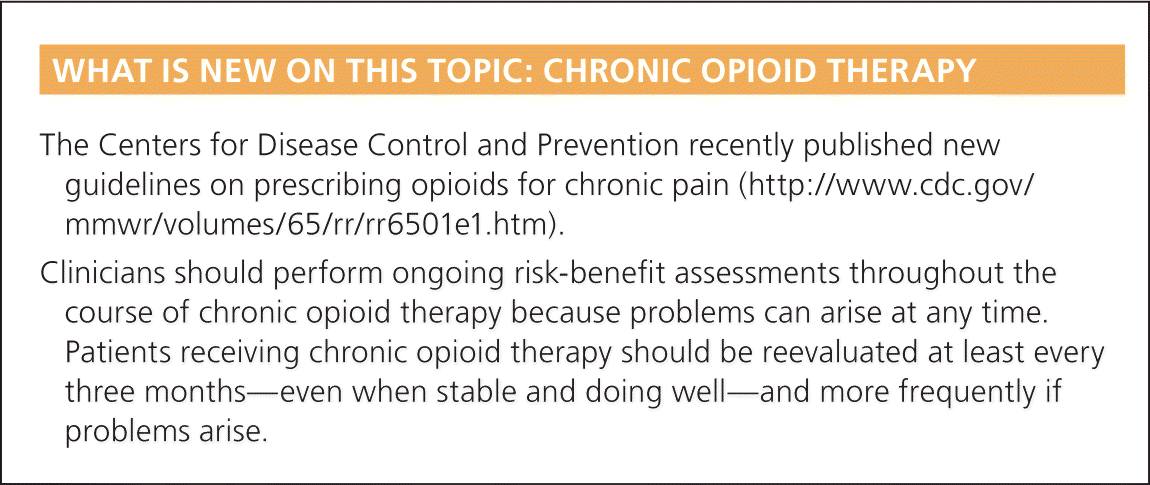
| Recommendation | Sponsoring organization |
|---|---|
| Do not prescribe opioid analgesics as first-line therapy to treat chronic noncancer pain. | American Society of Anesthesiologists |
| Do not prescribe opioid analgesics as long-term therapy to treat chronic noncancer pain until the risks are considered and discussed with the patient. | American Society of Anesthesiologists |
| Do not prescribe opioids for treatment of chronic or acute pain for workers who perform safety-sensitive jobs, such as operating motor vehicles, forklifts, cranes, or other heavy equipment. | American College of Occupational and Environmental Medicine |
The benefit of short-term opioid therapy is supported by multiple clinical trials.3 However, the benefit of opioids for managing chronic pain is limited. Chronic visceral or central pain syndromes (e.g., abdominal or pelvic pain, irritable bowel syndrome, fibromyalgia, headache, neuropathic pain) may be especially unresponsive to long-term opioid therapy. Furthermore, the risks associated with chronic opioid therapy increase in a dose-dependent manner.4
Nonetheless, chronic opioid therapy benefits some patients with chronic pain. The American Academy of Family Physicians urges physicians “to individualize therapy based on a review of the patient's potential risks, benefits, side effects, and functional assessments, and to monitor ongoing therapy accordingly.”5 This review explores how to assess and mitigate risks when initiating, continuing, and discontinuing chronic opioid therapy. For terms and definitions, see Table 1.6–8
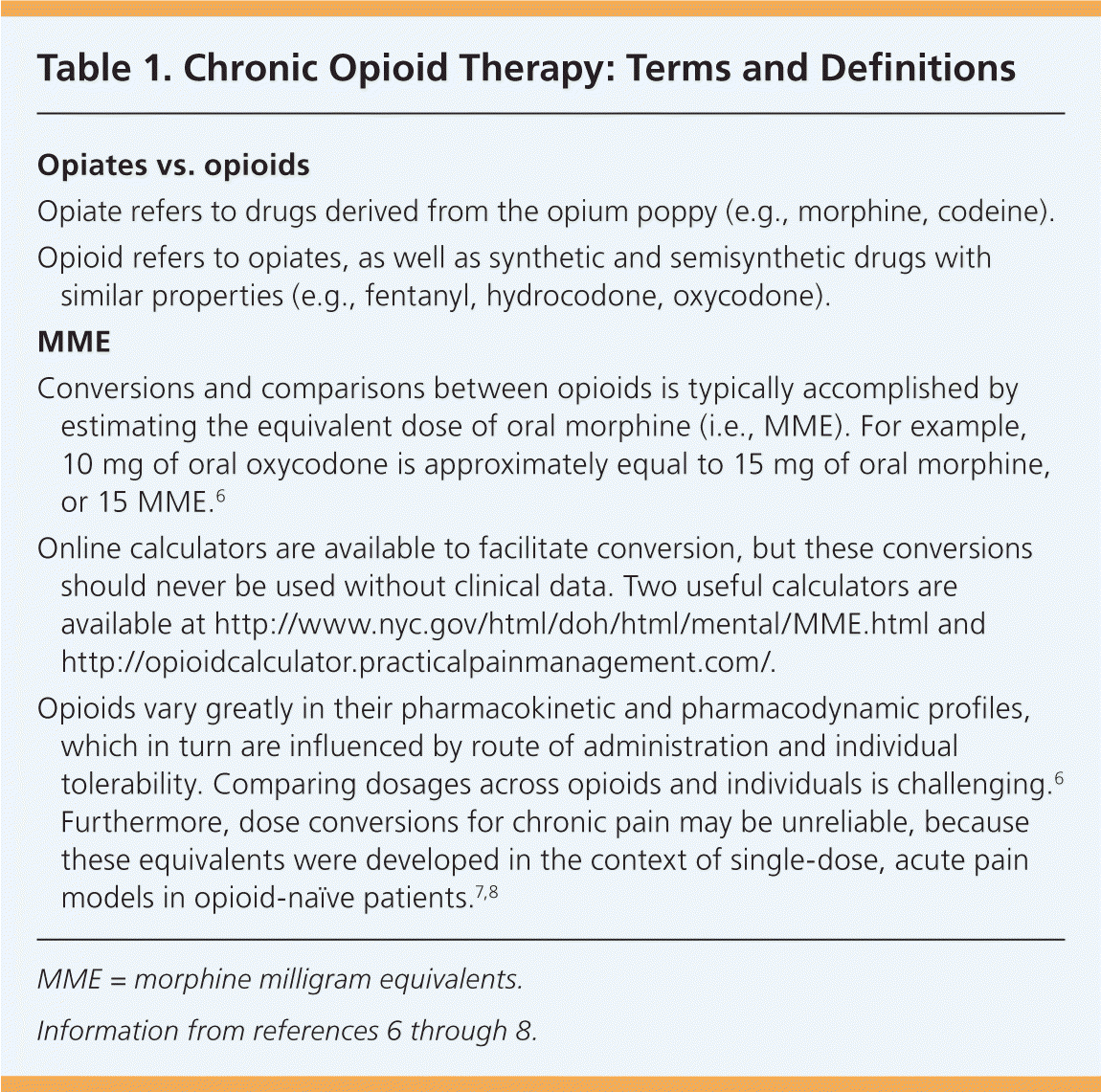
| Opiates vs. opioids |
| Opiate refers to drugs derived from the opium poppy (e.g., morphine, codeine). |
| Opioid refers to opiates, as well as synthetic and semisynthetic drugs with similar properties (e.g., fentanyl, hydrocodone, oxycodone). |
| MME |
| Conversions and comparisons between opioids is typically accomplished by estimating the equivalent dose of oral morphine (i.e., MME). For example, 10 mg of oral oxycodone is approximately equal to 15 mg of oral morphine, or 15 MME.6 |
| Online calculators are available to facilitate conversion, but these conversions should never be used without clinical data. Two useful calculators are available at http://www.nyc.gov/html/doh/html/mental/MME.html and http://opioidcalculator.practicalpainmanagement.com/. |
| Opioids vary greatly in their pharmacokinetic and pharmacodynamic profiles, which in turn are influenced by route of administration and individual tolerability. Comparing dosages across opioids and individuals is challenging.6 Furthermore, dose conversions for chronic pain may be unreliable, because these equivalents were developed in the context of single-dose, acute pain models in opioid-naïve patients.7,8 |
Risk Assessment When Initiating Chronic Opioid Therapy
Patients for whom chronic opioid therapy is being considered should be screened for risks and contraindications. Overdose is a key risk. Patients at increased risk of overdose include those with medical comorbidities (e.g., sleep apnea, lung disease, heart failure); those receiving benzodiazepines or other sedative-hypnotics9,10; those with problematic alcohol use; and those with psychiatric comorbidities (e.g., depression).
OPIOID MISUSE/OPIOID USE DISORDER
Opioid misuse and opioid use disorder are other key risk factors. Patients for whom chronic opioid therapy is being considered should be evaluated for these conditions.
Opioid misuse is the nontherapeutic use of opioids, including taking opioids in amounts other than prescribed, for indications other than prescribed, or by alternative routes of administration (e.g., crushing and snorting rather than ingesting). Opioid misuse is not always synonymous with an opioid use disorder.
Opioid use disorder (i.e., addiction) is defined in the Diagnostic and Statistical Manual of Mental Disorders, 5th ed., (DSM-5) by the presence of the three C's: control loss (out-of-control use), compulsivity (devoting increasing mental and physical resources to obtaining, using, and recovering from substances), and continued use despite adverse consequences. According to the DSM-5, the diagnosis of opioid use disorder excludes tolerance and adverse medical consequences, such as withdrawal symptoms, in patients taking opioids as prescribed.11 Although tolerance and withdrawal are often present in persons who meet DSM-5 criteria for an opioid use disorder, a person can have an opioid use disorder without tolerance or withdrawal because addiction is also a disease of learning, memory, and psychological compulsion.
Patients at increased risk of opioid misuse and opioid use disorder include those with a history of behaviors such as seeking early refills and “doctor-shopping”; those with a personal or family history of a substance use disorder 12; those with a preadolescent history of sexual abuse13; and those with psychiatric comorbidities.12 Screening for opioid misuse and opioid use disorder should include checking your state's prescription drug monitoring database14 (Table 2) and obtaining a urine toxicology screen. Approaches to mitigating risk before initiating chronic opioid therapy are outlined in Table 3.15–17
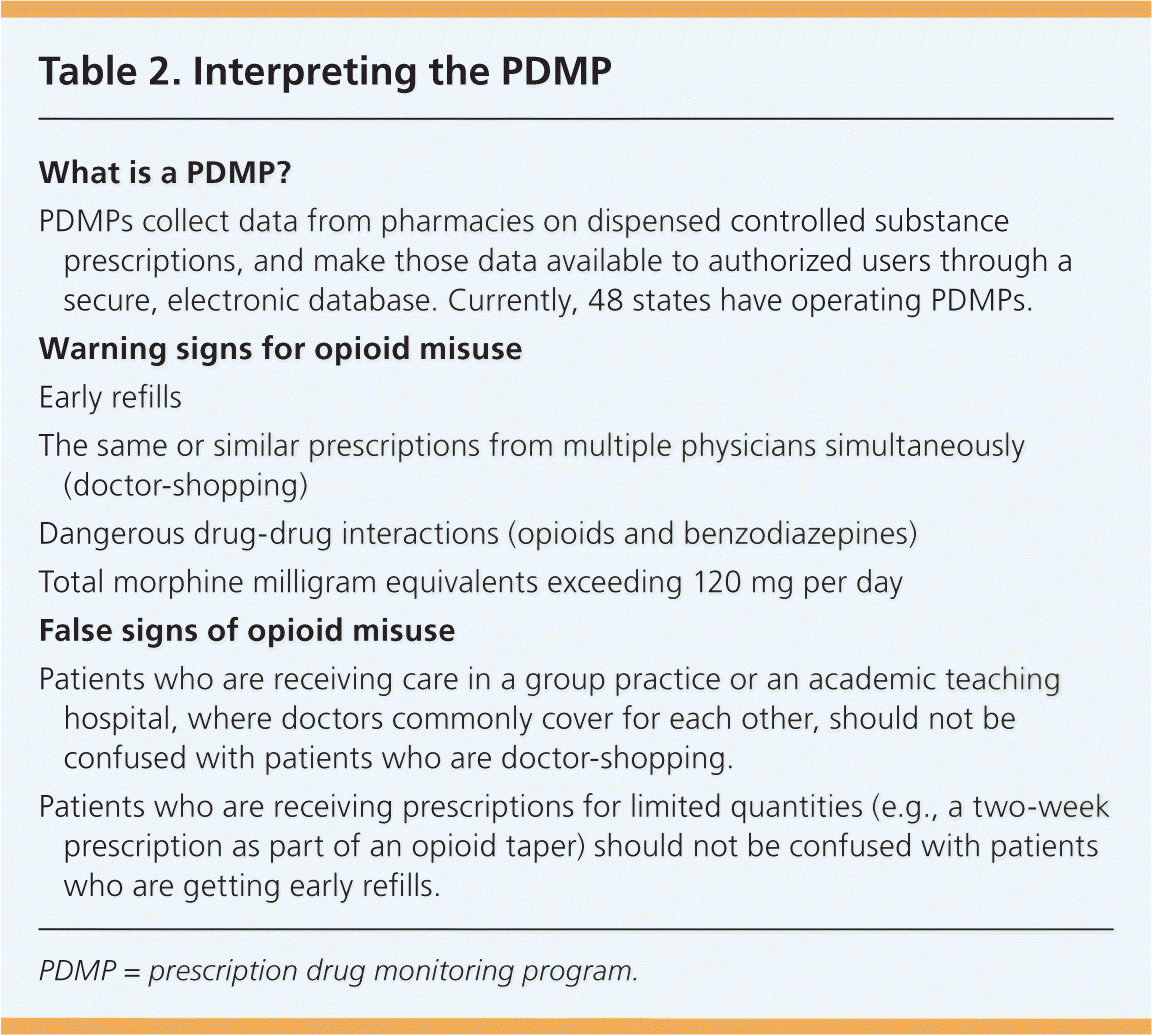
| What is a PDMP? |
| PDMPs collect data from pharmacies on dispensed controlled substance prescriptions, and make those data available to authorized users through a secure, electronic database. Currently, 48 states have operating PDMPs. |
| Warning signs for opioid misuse |
| Early refills |
| The same or similar prescriptions from multiple physicians simultaneously (doctor-shopping) |
| Dangerous drug-drug interactions (opioids and benzodiazepines) |
| Total morphine milligram equivalents exceeding 120 mg per day |
| False signs of opioid misuse |
| Patients who are receiving care in a group practice or an academic teaching hospital, where doctors commonly cover for each other, should not be confused with patients who are doctor-shopping. |
| Patients who are receiving prescriptions for limited quantities (e.g., a two-week prescription as part of an opioid taper) should not be confused with patients who are getting early refills. |
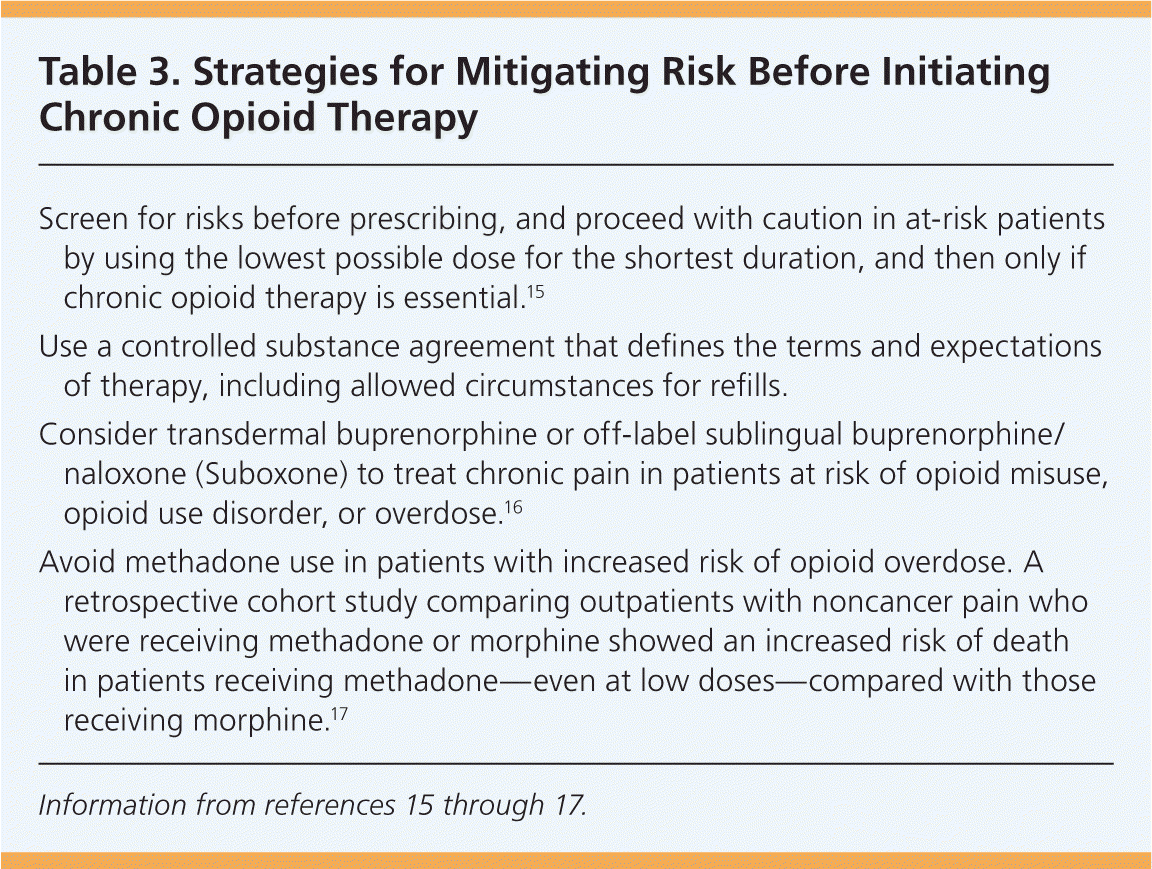
| Screen for risks before prescribing, and proceed with caution in at-risk patients by using the lowest possible dose for the shortest duration, and then only if chronic opioid therapy is essential.15 |
| Use a controlled substance agreement that defines the terms and expectations of therapy, including allowed circumstances for refills. |
| Consider transdermal buprenorphine or off-label sublingual buprenorphine/naloxone (Suboxone) to treat chronic pain in patients at risk of opioid misuse, opioid use disorder, or overdose.16 |
| Avoid methadone use in patients with increased risk of opioid overdose. A retrospective cohort study comparing outpatients with noncancer pain who were receiving methadone or morphine showed an increased risk of death in patients receiving methadone—even at low doses—compared with those receiving morphine.17 |
PATIENT EDUCATION
Before initiating chronic opioid therapy, physicians should take adequate time to inform patients in simple language of the associated risks (Table 4). Patient education can help curb opioid misuse and reduce the risk of developing opioid use disorder. Numerous free continuing medical education options are available online for physicians to learn more about safe opioid prescribing, such as http://www.drugabuse.gov/opioid-pain-management-cmesces and http://www.health.gov/hcq/training-pathways.asp.
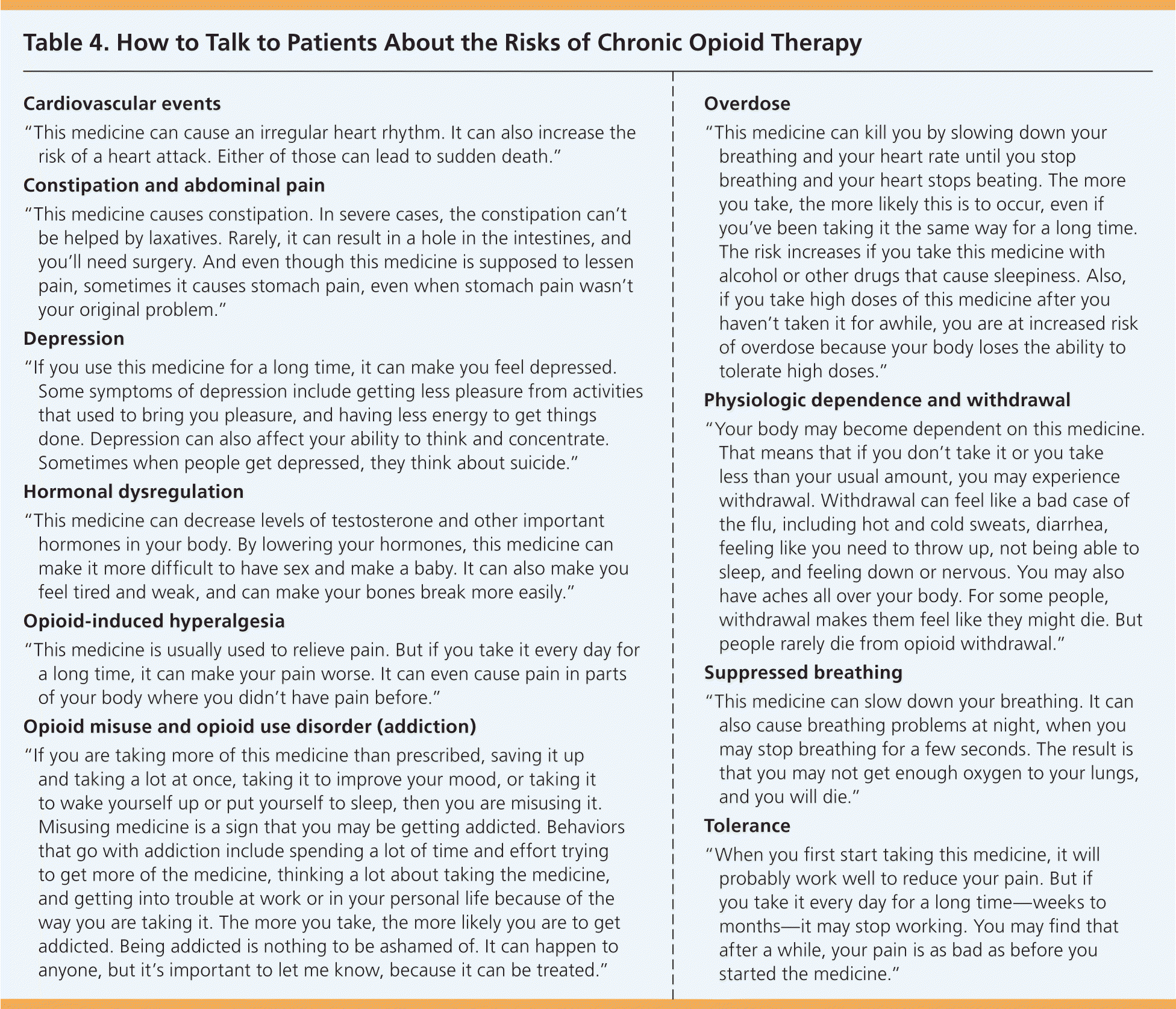
| Cardiovascular events |
| “This medicine can cause an irregular heart rhythm. It can also increase the risk of a heart attack. Either of those can lead to sudden death.” |
| Constipation and abdominal pain |
| “This medicine causes constipation. In severe cases, the constipation can't be helped by laxatives. Rarely, it can result in a hole in the intestines, and you'll need surgery. And even though this medicine is supposed to lessen pain, sometimes it causes stomach pain, even when stomach pain wasn't your original problem.” |
| Depression |
| “If you use this medicine for a long time, it can make you feel depressed. Some symptoms of depression include getting less pleasure from activities that used to bring you pleasure, and having less energy to get things done. Depression can also affect your ability to think and concentrate. Sometimes when people get depressed, they think about suicide.” |
| Hormonal dysregulation |
| “This medicine can decrease levels of testosterone and other important hormones in your body. By lowering your hormones, this medicine can make it more difficult to have sex and make a baby. It can also make you feel tired and weak, and can make your bones break more easily.” |
| Opioid-induced hyperalgesia |
| “This medicine is usually used to relieve pain. But if you take it every day for a long time, it can make your pain worse. It can even cause pain in parts of your body where you didn't have pain before.” |
| Opioid misuse and opioid use disorder (addiction) |
| “If you are taking more of this medicine than prescribed, saving it up and taking a lot at once, taking it to improve your mood, or taking it to wake yourself up or put yourself to sleep, then you are misusing it. Misusing medicine is a sign that you may be getting addicted. Behaviors that go with addiction include spending a lot of time and effort trying to get more of the medicine, thinking a lot about taking the medicine, and getting into trouble at work or in your personal life because of the way you are taking it. The more you take, the more likely you are to get addicted. Being addicted is nothing to be ashamed of. It can happen to anyone, but it's important to let me know, because it can be treated.” |
| Overdose |
| “This medicine can kill you by slowing down your breathing and your heart rate until you stop breathing and your heart stops beating. The more you take, the more likely this is to occur, even if you've been taking it the same way for a long time. The risk increases if you take this medicine with alcohol or other drugs that cause sleepiness. Also, if you take high doses of this medicine after you haven't taken it for awhile, you are at increased risk of overdose because your body loses the ability to tolerate high doses.” |
| Physiologic dependence and withdrawal |
| “Your body may become dependent on this medicine. That means that if you don't take it or you take less than your usual amount, you may experience withdrawal. Withdrawal can feel like a bad case of the flu, including hot and cold sweats, diarrhea, feeling like you need to throw up, not being able to sleep, and feeling down or nervous. You may also have aches all over your body. For some people, withdrawal makes them feel like they might die. But people rarely die from opioid withdrawal.” |
| Suppressed breathing |
| “This medicine can slow down your breathing. It can also cause breathing problems at night, when you may stop breathing for a few seconds. The result is that you may not get enough oxygen to your lungs, and you will die.” |
| Tolerance |
| “When you first start taking this medicine, it will probably work well to reduce your pain. But if you take it every day for a long time—weeks to months—it may stop working. You may find that after a while, your pain is as bad as before you started the medicine.” |
Risk Assessment When Continuing Chronic Opioid Therapy
Risk assessment should not be limited to an evaluation before prescribing chronic opioid therapy. Physicians should also perform ongoing risk-benefit assessments throughout the course of therapy because problems can arise at any point. Patients should be reevaluated at least every three months, even when stable and doing well, and more frequently if problems arise.15 If measures to counteract misuse and adverse effects are not successful, opioids should be decreased or discontinued. Opioids should not be discontinued abruptly; doing so can precipitate acute opioid withdrawal.
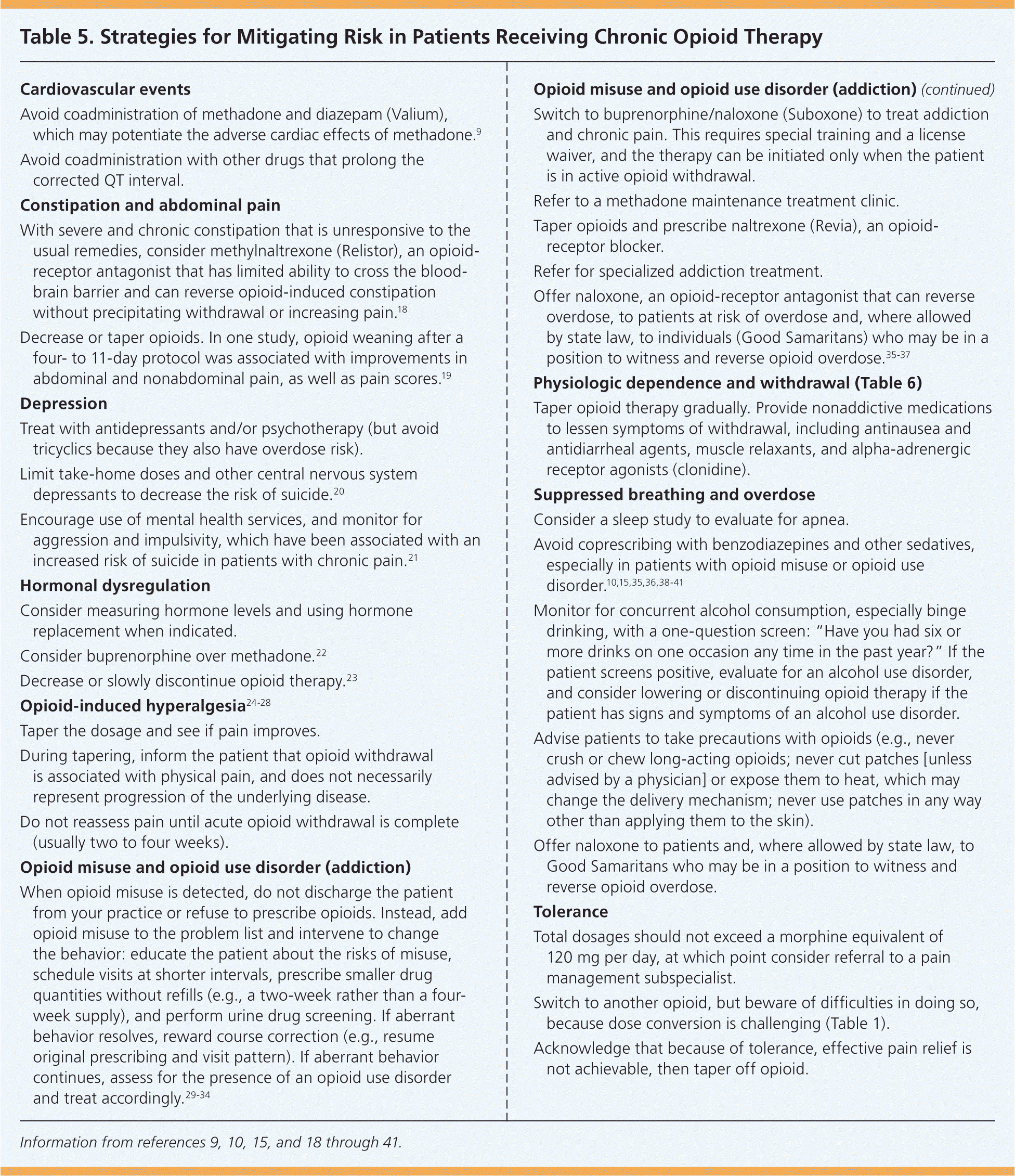
| Cardiovascular events |
| Avoid coadministration of methadone and diazepam (Valium), which may potentiate the adverse cardiac effects of methadone.9 |
| Avoid coadministration with other drugs that prolong the corrected QT interval. |
| Constipation and abdominal pain |
| With severe and chronic constipation that is unresponsive to the usual remedies, consider methylnaltrexone (Relistor), an opioid-receptor antagonist that has limited ability to cross the blood-brain barrier and can reverse opioid-induced constipation without precipitating withdrawal or increasing pain.18 |
| Decrease or taper opioids. In one study, opioid weaning after a four- to 11-day protocol was associated with improvements in abdominal and nonabdominal pain, as well as pain scores.19 |
| Depression |
| Treat with antidepressants and/or psychotherapy (but avoid tricyclics because they also have overdose risk). |
| Limit take-home doses and other central nervous system depressants to decrease the risk of suicide.20 |
| Encourage use of mental health services, and monitor for aggression and impulsivity, which have been associated with an increased risk of suicide in patients with chronic pain.21 |
| Hormonal dysregulation |
| Consider measuring hormone levels and using hormone replacement when indicated. |
| Consider buprenorphine over methadone.22 |
| Decrease or slowly discontinue opioid therapy.23 |
| Opioid-induced hyperalgesia24–28 |
| Taper the dosage and see if pain improves. |
| During tapering, inform the patient that opioid withdrawal is associated with physical pain, and does not necessarily represent progression of the underlying disease. |
| Do not reassess pain until acute opioid withdrawal is complete (usually two to four weeks). |
| Opioid misuse and opioid use disorder (addiction) |
| When opioid misuse is detected, do not discharge the patient from your practice or refuse to prescribe opioids. Instead, add opioid misuse to the problem list and intervene to change the behavior: educate the patient about the risks of misuse, schedule visits at shorter intervals, prescribe smaller drug quantities without refills (e.g., a two-week rather than a four-week supply), and perform urine drug screening. If aberrant behavior resolves, reward course correction (e.g., resume original prescribing and visit pattern). If aberrant behavior continues, assess for the presence of an opioid use disorder and treat accordingly.29–34 |
| Switch to buprenorphine/naloxone (Suboxone) to treat addiction and chronic pain. This requires special training and a license waiver, and the therapy can be initiated only when the patient is in active opioid withdrawal. |
| Refer to a methadone maintenance treatment clinic. |
| Taper opioids and prescribe naltrexone (Revia), an opioid-receptor blocker. |
| Refer for specialized addiction treatment. |
| Offer naloxone, an opioid-receptor antagonist that can reverse overdose, to patients at risk of overdose and, where allowed by state law, to individuals (Good Samaritans) who may be in a position to witness and reverse opioid overdose.35–37 |
| Physiologic dependence and withdrawal (Table 6) |
| Taper opioid therapy gradually. Provide nonaddictive medications to lessen symptoms of withdrawal, including antinausea and antidiarrheal agents, muscle relaxants, and alpha-adrenergic receptor agonists (clonidine). |
| Suppressed breathing and overdose |
| Consider a sleep study to evaluate for apnea. |
| Avoid coprescribing with benzodiazepines and other sedatives, especially in patients with opioid misuse or opioid use disorder.10,15,35,36,38–41 |
| Monitor for concurrent alcohol consumption, especially binge drinking, with a one-question screen: “Have you had six or more drinks on one occasion any time in the past year?” If the patient screens positive, evaluate for an alcohol use disorder, and consider lowering or discontinuing opioid therapy if the patient has signs and symptoms of an alcohol use disorder. |
| Advise patients to take precautions with opioids (e.g., never crush or chew long-acting opioids; never cut patches [unless advised by a physician] or expose them to heat, which may change the delivery mechanism; never use patches in any way other than applying them to the skin). |
| Offer naloxone to patients and, where allowed by state law, to Good Samaritans who may be in a position to witness and reverse opioid overdose. |
| Tolerance |
| Total dosages should not exceed a morphine equivalent of 120 mg per day, at which point consider referral to a pain management subspecialist. |
| Switch to another opioid, but beware of difficulties in doing so, because dose conversion is challenging (Table 1). |
| Acknowledge that because of tolerance, effective pain relief is not achievable, then taper off opioid. |
Risks Associated with Chronic Opioid Therapy
CONSTIPATION AND ABDOMINAL PAIN
Chronic opioid therapy can also cause worsened or new-onset abdominal pain, although this is much less common than constipation. This condition is referred to as narcotic bowel syndrome and is characterized by progressive pain despite maintaining or increasing opioid doses. It can occur in patients with no history of gastrointestinal disorders.45,46 In a study of 146 ambulatory patients with chronic noncancer pain, the prevalence of narcotic bowel syndrome—defined as daily severe to very severe abdominal pain of more than three months' duration requiring more than 100 morphine milligram equivalents (MME) daily—was 6.4% (95% confidence interval, 2.4 to 13.5).24
TOLERANCE
Tolerance is the physiologic adaptation to opioid therapy, as evidenced by the need for increasing doses to get the same effects, or the loss of effectiveness at a given dose. Although the prevalence of tolerance has not been well described, one study found that nearly 28% of persons receiving chronic opioid therapy required increased doses for reasons that could not be explained by progression of their underlying condition or increases in activity level.47 Another study reported that patients younger than 50 years had a fourfold dose escalation and older patients had a twofold escalation over two years of opioid therapy.48
PHYSIOLOGIC DEPENDENCE AND WITHDRAWAL
Physiologic dependence is the process whereby the body comes to rely on the drug to maintain biochemical homeostasis. When the drug is not available at expected doses or time intervals, the body becomes biochemically dysregulated, which manifests as signs and symptoms of withdrawal. Opioid withdrawal occurs in patients with physiologic dependence when lowering or discontinuing opioids, but it can also happen when changing the type or method of delivery, or when transitioning from one opioid to another with less bioavailability.
Opioid withdrawal symptoms include arthralgias, myalgias, piloerection, rhinorrhea, diaphoresis, nausea, emesis, muscle cramps/spasms, and diffuse muscle and bone pain. Common behavior and mood changes experienced during withdrawal include insomnia, dysphoria, irritability, and anxiety. Opioid withdrawal can present similarly to influenza. When patients receiving chronic opioid therapy exhibit sudden-onset “flu-like” symptoms, physicians should consider a recent decrease or discontinuation of opioids as the cause.
OPIOID MISUSE/OPIOID USE DISORDER
Historically, the risk of opioid use disorder from agents prescribed by a licensed physician for treatment of a medical condition was considered small.49,50 However, recent reports indicate higher rates of opioid use disorder in this population than previously assumed, with some studies finding prevalence rates as high as 50% in patients receiving chronic opioid therapy.29–33 The risk of developing new-onset opioid use disorder in opioid-naïve adults increases with the opioid dosage and duration of treatment. Patients receiving opioid therapy for more than 90 days at doses of more than 120 MME are more than 100 times as likely to develop opioid use disorder than patients who do not receive opioids for similar conditions.34
DEPRESSION
There is a complex relationship between chronic opioid use, worsening of chronic pain, and symptoms of depression. A study of medical record data from 49,770 patients determined that those receiving opioids for 90 to 180 days had a 25% increased risk of depression, and those receiving them for more than 180 days had a greater than 50% increased risk.51 These data are salient because the population studied was at low risk of depression at baseline, with no recent history of depression before initiation of opioids. The study also adjusted its analysis for symptoms related to several chronic pain states, an important confounder to consider because progression of pain symptoms that are unresponsive to opioids can lead to depressive symptoms as well.
Opioids are often discovered in a person's possession at the time of suicide-related drug overdoses. Data collected from the National Violent Death Reporting System in 16 states revealed that in 23% of deaths (most of which are suicide-related), the deceased person tested positive for antidepressants, and 20.8% tested positive for opioids.52 However, understanding the exact role of opioids is often complex, as is the determination of whether an overdose was accidental or intentional.20
HORMONAL DYSREGULATION
Chronic opioid therapy can cause increased prolactin levels and decreased levels of cortisol, testosterone, estrogen, luteinizing hormone, and follicle-stimulating hormone. These hormonal changes contribute to sexual dysfunction,53 infertility, fatigue, osteoporosis, oligomenorrhea, and galactorrhea.54
OPIOID-INDUCED HYPERALGESIA
Opioid-induced hyperalgesia is the development of increased pain in response to protracted opioid exposure. Whereas opioids have powerful short-term analgesic effects, animal and human studies show that prolonged use can cause heightened pain sensitivity and result in pain syndromes that did not previously exist.25 The prevalence of opioid-induced hyperalgesia has not been determined.47 One small prospective study of six patients with chronic low back pain who were receiving oral morphine demonstrated that all six developed hyperalgesia to cold pressor pain testing after four weeks.26
Clinically differentiating tolerance from opioid-induced hyperalgesia can be difficult. As a general rule, patients who have developed tolerance to opioids will have recurrent pain in the original anatomic location despite initial relief, and the pain is improved by increasing the opioid dose. With opioid-induced hyperalgesia, pain becomes heightened in the same or a new anatomic location and is improved by decreasing the opioid dose.27,28
CARDIOVASCULAR EVENTS
Chronic opioid therapy has been associated with sudden cardiac death, possibly as a result of torsade de pointes precipitated by prolongation of the corrected QT interval.55–57 The available evidence most strongly implicates methadone in opioid-induced cardiac arrhythmias.55,58 Myocardial infarction may also be a contributing factor; a cohort study including patients receiving diverse prescription opioids showed an increased risk of myocardial infarction compared with persons who were not receiving opioids.59
SUPPRESSED BREATHING AND ACCIDENTAL OVERDOSE
Patients receiving opioid therapy are at increased risk of death from respiratory suppression, bradycardia, and hypotension. In a sample of 9,940 persons who received three or more opioid prescriptions over 90 days, there were 51 overdoses and six deaths, and the risk of overdose was dose dependent.10 Compared with patients receiving 1 to 20 MME of opioids daily, those receiving 50 to 99 MME per day had a 3.7-fold increased risk of overdose, and those receiving 100 MME or more per day had an 8.9-fold increased risk. Another study of 607,156 persons 15 to 64 years of age who were prescribed an opioid found that an average daily dosage of 200 MME was associated with a nearly threefold increase in opioid-related mortality (odds ratio = 2.88) compared with low daily dosages (less than 20 MME).38
The risk of overdose increases when opioids are combined with sedatives such as alcohol, benzodiazepines, muscle relaxants, or sedative-hypnotics.10 In such cases, overdose can occur at therapeutic analgesic opioid doses, in part because of drug-drug interactions, and because the physiologic tolerance to the analgesic effects of opioids does not necessarily coincide with tolerance to the respiratory effects.35 Furthermore, those who resume opioid therapy after a period of abstinence (e.g., recently released prisoners) are at increased risk of accidental overdose because of the interim loss of tolerance.36,39
Risk Assessment When Discontinuing Chronic Opioid Therapy
When the risks of chronic opioid therapy outweigh the benefits, opioids should be slowly decreased and/or discontinued. This can present a challenging clinical scenario, particularly when patients have become dependent. Except in cases of overtly illegal activity (diversion), chronic opioid therapy should not be discontinued abruptly.60 This can precipitate intolerable opioid withdrawal, and in some cases lead patients to seek illicit opioids. Table 6 provides strategies to mitigate risks when discontinuing chronic opioid therapy.60
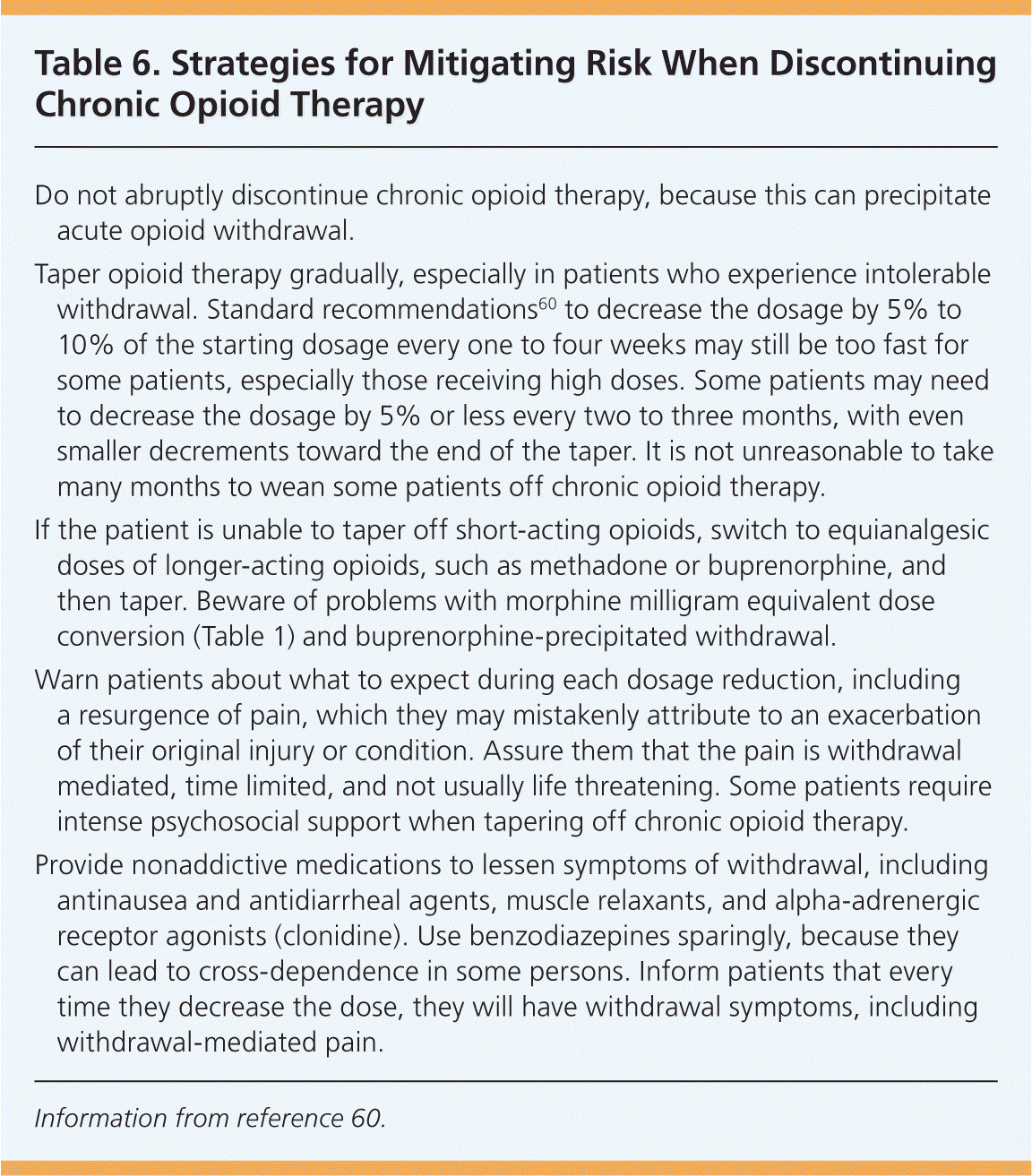
| Do not abruptly discontinue chronic opioid therapy, because this can precipitate acute opioid withdrawal. |
| Taper opioid therapy gradually, especially in patients who experience intolerable withdrawal. Standard recommendations60 to decrease the dosage by 5% to 10% of the starting dosage every one to four weeks may still be too fast for some patients, especially those receiving high doses. Some patients may need to decrease the dosage by 5% or less every two to three months, with even smaller decrements toward the end of the taper. It is not unreasonable to take many months to wean some patients off chronic opioid therapy. |
| If the patient is unable to taper off short-acting opioids, switch to equianalgesic doses of longer-acting opioids, such as methadone or buprenorphine, and then taper. Beware of problems with morphine milligram equivalent dose conversion (Table 1) and buprenorphine-precipitated withdrawal. |
| Warn patients about what to expect during each dosage reduction, including a resurgence of pain, which they may mistakenly attribute to an exacerbation of their original injury or condition. Assure them that the pain is withdrawal mediated, time limited, and not usually life threatening. Some patients require intense psychosocial support when tapering off chronic opioid therapy. |
| Provide nonaddictive medications to lessen symptoms of withdrawal, including antinausea and antidiarrheal agents, muscle relaxants, and alpha-adrenergic receptor agonists (clonidine). Use benzodiazepines sparingly, because they can lead to cross-dependence in some persons. Inform patients that every time they decrease the dose, they will have withdrawal symptoms, including withdrawal-mediated pain. |
Data Sources: Searches of the human, English literature were conducted in Essential Evidence Plus, Google Scholar, and Medline for clinical trials and guidelines using the major keywords of chronic pain, chronic opioid therapy, risks, adverse medical consequences, and non-cancer. Search dates: January 2010 through March 2016.
